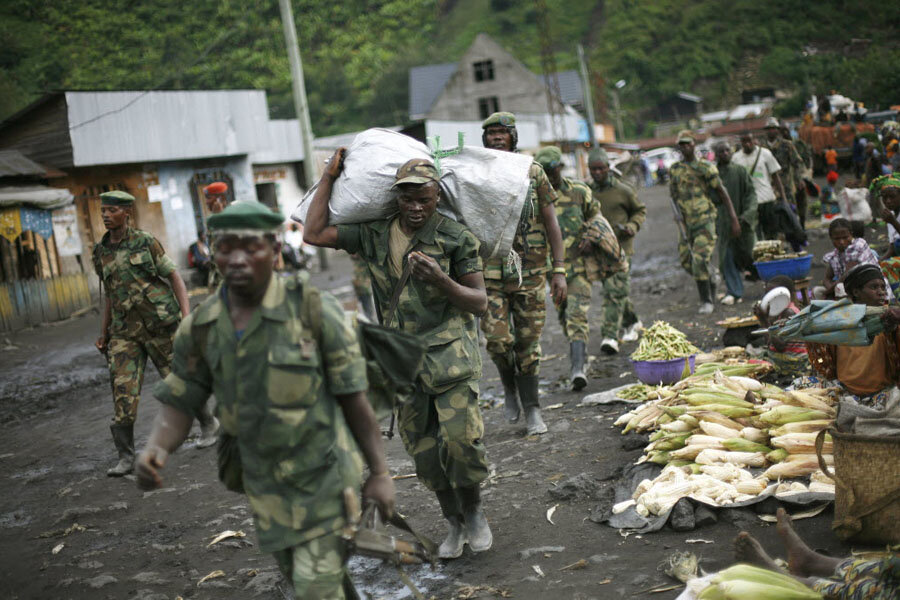Why the UN is planning fresh military offensive in Congo: briefing
Loading...
| Nairobi, Kenya
Spurred by UN Secretary-General Ban Ki-moon's call for "decisive action" after the the largest rebel force in eastern Congo missed a January disarmament deadline, the UN is pushing a military effort to dismantle the group.
The operation will target the Democratic Forces for the Liberation of Rwanda (FDLR), the Goliath of dozens of rebel groups in the region. But it could also serve another long-elusive goal: destabilizing and rooting out many other armed groups that have roiled the region since the 1994 genocide in Rwanda forced 1.2 million Hutus to flee into Congo.
Discussions on how to go forward have started between the UN Stabilization Mission in the Democratic Republic of the Congo (MONUSCO) and the three countries that will contribute soldiers: South Africa, Malawi, and Tanzania. South Africa's President Jacob Zuma is expected to meet with Lieut.-Gen. Carlos Alberto Dos Santos Cruz, commander of the UN peacekeeping force, on Thursday, Bloomberg News reported.
Neither the UN nor Congolese officials have specified when exercises against the FDLR will begin, nor have they offered estimates of how long it will take. The push is the most significant call for action since twice postponing military initiatives over the past year to allow more time for the FDLR to fulfill its disarmament pledges.
What is the FDLR?
The FDLR is a Rwandan Hutu rebel group that has become one of the most prominent armed groups in eastern Congo. The second-largest country in Africa, Congo has a population of 77 million and sits in the central part of the continent. Some FDLR leaders played a role in the 1994 Rwandan genocide, and the group has a gruesome track record in the region. The primary raison d'être of the group is to overthrow the Rwandan government.
At one point, the FDLR had up to 13,000 fighters, but now has only about 1,400, according to MONUSCO estimates. An exact number is difficult to pin down because they are well integrated in communities and include a growing number of Congolese, says Thierry Vircoulon, Central Africa Project Director for the International Crisis Group.
Why has this group been singled out?
If the FDLR is defeated, many of the other armed groups in the region will dissolve – or so the thinking goes. “Many of them [the other rebel groups] will tell you that they exist because the FDLR is around and poses a threat to the local population,” says Timo Mueller, an independent analyst on eastern Congo based in Goma.
Evidence bolstering this hope lies in the local Tutsi armed group M23. M23 was taken down by MONUSCO and the Congolese Army in 2013, with some 4,000 or 5,000 fighters surrendering. Rebel groups that formed in defiance of M23 lost their central purpose once the group was demolished, Mr. Mueller says.
Why is military action being considered?
The FDLR failed to deliver on its promise to lay down arms and surrender by a Jan. 2 deadline, the second to be missed by the militia group. Instead it used the six-month lead-up to the deadline to continue recruiting and arming itself, observers say. Only a few hundred fighters gave themselves up.
“It is clear that the FDLR has been given more than ample time to surrender already. The giving of six months was a very generous period of time. The only reason it occurred is that the FDLR claimed as early as about a year ago that they were going to surrender, and fully surrender. … So the notion that somehow another delay should be granted is absurd on its face,” said Russ Feingold, the US special envoy to the Great Lakes region,in a teleconference on Dec. 30.
What are the chances of success?
Not good – and yet military action seems to be the only option being considered now.
While proponents of military action point to MONUSCO’s success against the M23 – an effort that was backed by Rwanda – it’s a flawed comparison, experts say.
The fight against the M23 had the full support of regional governments, in addition to the Congolese Army. But the Congolese Army's thinking on the FDLR may be different now. The Army has found the rebel group to be a “useful proxy” against its enemies, Mueller says, who calls the FDLR a “convenient troublemaker” for the Congo.
MONUSCO may be able to clear areas, but without the backing of the Army, it won’t hold them, says Mueller, the independent analyst.
The push against the FDLR also lacks ardent support from South Africa and Tanzania, which provide the bulk of the fighters for the intervention brigade that would help carry out the operation. They went all-in for the fight against M23, but “Pretoria and Dar don’t see the FDLR as the same as M23,” Vircoulon says. Doubt about Tanzania's willingness to tackle the FDLR stems from a number of statements suggesting some sympathy to the rebel force's cause.
"There are people who pretend to read Tanzania's mind," Tanzanian President Jakaya Kikwete said. "They claim that Tanzania has no intention of taking on rebel groups in the DRC. These are bizarre people because Tanzania, like South Africa and Malawi, has troops in the DRC with a firm United Nations mandate."
The FDLR is also far more scattered throughout eastern Congo than the M23 was. Their ability to blend into the civilian population makes them difficult to target, and fears of imprisonment in Rwanda if captured reduces their likelihood of surrender. Because of this obstacle, Vircoulon says, a more pointed operation against the FDLR’s leaders is a better tactic than targeting the overall force. Bush fighters aren’t very committed; if they lost their leaders, they would probably give up, he says.






